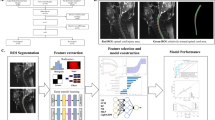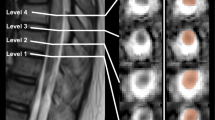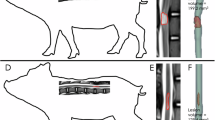Abstract
Many models have been developed to study spinal cord injury (SCI), such as cryogenic lesioning, hot water injury, scalpel lesioning, compressive trauma using clips, electromechanical devices, extradural cuffs, and weight-drop techniques. In this study, the radiofrequency (RF) lesion was used for inducing an experimental SCI in cats. The neuropathology was correlated with the MRI. In this model, 4 cats were injured at the thoracic spinal cord (T11-T12) with a lesion of 65°C for 1 min using a micromanipulated penetrating RF electrode. The MRI of the lesions after 2, 3, 5, and 6 weeks post-injury as well as the correlative histological changes were obtained. The RF-induced lesion was discrete with little spreading across the spinal cord. There was a good correlation between the histopathology findings and the MRI. We conclude that experimental RF lesioning of the spinal cord can produce a consistent lesion with predictable histopathological changes in experimental animals. A 65°C injury for 1 min induced a clinical picture of an incomplete SCI. The RF lesioning should be considered as a new model to study SCI, particularly those with a penetrating component
Similar content being viewed by others
Log in or create a free account to read this content
Gain free access to this article, as well as selected content from this journal and more on nature.com
or
References
Tator C H, Duncan E G, Lapczak L I, Andrews D F . Changes in epidemiology of acute spinal cord injury from 1947 to 1981. Surg Neurol 1993; 40: 207–215.
Burney R E, Maio R F, Maynard F, Karunas R . Incidence, characteristics and outcome of spinal cord injury at trauma centers in North America. Arch Surg 1993; 128: 596–599.
Martin D et al. Experimental acute traumatic injury of the adult rat spinal cord by a subdural inflatable balloon: methodology, behavioral analysis, and histopathology. J Neurosci Res 1992; 32: 539–550.
Schramm J, Krause R, Shigeno T, Brock M . Experimental investigation on the spinal cord evoked injury potential. J Neurosurg 1983; 59: 485–492.
Stokes B T, Noyes D H, Behrmann D L . An electromechanical spinal cord injury technique with dynamic sensitivity. J Neurotrauma 1992; 9: 187–195.
West N R, Collins G H . Cellular changes during repair of a cryogenic spinal cord injury in the rat: an electron microscopic study. J Neuropathol Exp Neurol 1989; 48: 94–108.
Sasaki M, Ide C . Aberrant remyelination of axons after heat injury in the dorsal funiculus of rat spinal cord. Acta Neuropathol 1991; 81: 557–561.
Watson B D et al. Photochemically induced spinal cord injury in the rat. Brain Res 1986; 367: 293–300.
Rivlin A S, Tator C H . Effect of duration of spinal cord injury compression in a new acute cord injury model in the rat. Surg Neurol 1978; 10: 39–43.
Allen A R . Surgery of experimental lesion of spinal cord equivalent to crush injury of fracture dislocation of spinal column. Preliminary report. JAMA 1911: 57: 878.
Gruner J A . A monitored contusion model of spinal cord injury in the rat. J Neurotrauma 1992; 9: 151–154.
Blight A, Decrescito V . Morphometric analysis of experimental spinal cord injury in the cat: the relation of injury intensity to survival of myelinated axons. Neuroscience 1986; 19: 321–341.
Panjabi M M . Experimental spinal cord trauma. A biomechanical viewpoint. Paraplegia 1987; 25: 217–220.
Hackney D B et al. Hemorrhage and edema in acute spinal cord compression: demonstration by MR imaging. Radiology 1986; 161: 387–390.
Tarlov I M . Spinal cord compression studies III. Time limits for recovery after gradual compression in dogs. Arch Neurol Psychiat 1954; 71: 588–597.
Hovda D, Becker D, Katayama Y . Secondary injury in acidosis. Neurotrauma 1992; 9(S1): S47–S60.
Tator C H, Fehlings M G . Review of the secondary injury theory of acute spinal cord trauma: J Neurosurg 1991; 75: 15–26.
Cohen W A et al. Posttraumatic syrinx formation: experimental study. AJNR 1985; 6: 823–827.
Goldberg A L et al. The impact of magnetic resonance on the diagnostic evaluation of acute cervicothoracic spinal trauma. Skelet Radiol 1988; 17: 89–95.
Matsumura A et al. Magnetic resonance imaging of spinal cord injury without radiologic abnormality. Surg Neurol 1990; 33: 281–283.
Mirvis S E et al. Acute cervical spine trauma: evaluation with 1.5-T MR imaging. Radiology 1988; 166: 807–816.
Quencer R M et al. Magnetic resonance imaging of the chronically injured cervical spinal cord: AJNR 1986; 7: 457–464.
Bondurant F J et al. Acute spinal cord injury. A study using physical examination and magnetic resonance imaging. Spine 1990; 15: 161–168.
Kulkarni M V, Bondurant F J, Rose S L, Narayana P A . 1.5 tesla magnetic resonance imaging of acute spinal trauma. Radio-Graphics 1988; 8: 1059–1082.
Kulkarni M V et al. Acute spinal cord injury: MR imaging at 1.5T. Radiology 1987; 4: 837–843.
Weirich S D et al. Histopathological correlation of magnetic resonance imaging signal patterns in a spinal cord injury model. Spine 1990; 15: 630–638.
Mayer S J, Kulkarni M V . MR Imaging of incisional spinal cord injury. AJNR 1987; 8: 925–927.
Edelman R R, Warach S . Magnetic resonance imaging (Part I). N Engl J Med 1993; 328: 708–716.
Kadoya S, Nakamura T, Kobayashi S, Yamamoto I . Magnetic resonance imaging of acute spinal cord injury. Report of three cases. Neuroradiology 1987; 29: 252–255.
Schouman-Claeys E et al. MR imaging of acute spinal cord injury: results of an experimental study in dogs. AJNR 1990; 11: 959–965.
Author information
Authors and Affiliations
Rights and permissions
About this article
Cite this article
Haghighi, S., Perez-Espejo, MA., Rodriguez, F. et al. Radiofrequency as a lesioning model in experimental spinal cord injury. Spinal Cord 34, 214–219 (1996). https://doi.org/10.1038/sc.1996.40
Issue date:
DOI: https://doi.org/10.1038/sc.1996.40



